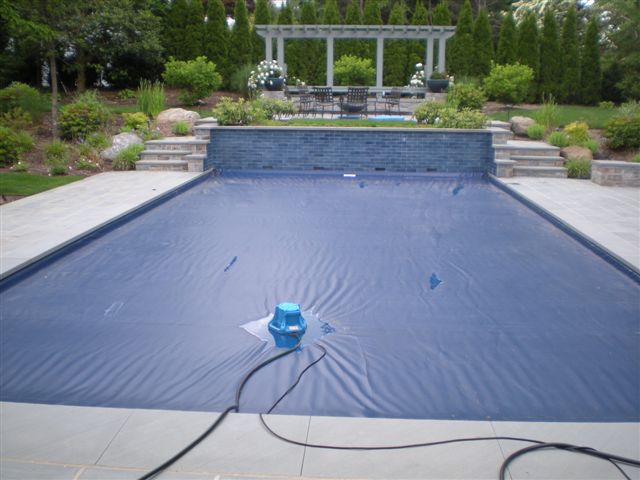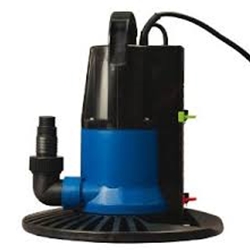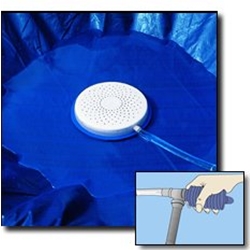If you are going to invest in a solid vinyl winter pool cover to protect your swimming pool during the off-season, you’ll also want to invest in a quality pool cover pump to protect that expensive cover. Winterizing and closing a swimming pool is multistep process and a pool cover pump that removes rainwater and snowmelt is an essential item for your winterizing checklist. In addition to helping maintain the integrity of your winter pool cover, having a dry pool cover will simplify the springtime pool opening process as well.
Water Buildup Can be a Death Sentence for  Pool Covers
Regardless of where you live, the weight of standing water on top of a winter pool cover can greatly reduce its lifespan. In colder climates, rainwater and melting snow and ice can freeze and seriously damage the cover’s material. Even in locations where winter temperatures rarely drop below 32O F, a pond of still water sitting on top of a pool cover provides a breeding ground for harmful bacteria and mosquitoes. A pool cover pump removes excess water from a pool cover quickly and efficiently.
Types of Pool Cover Pumps
There are two basic types of pool cover pumps: automatic and manual. Both types are compact and lightweight and attach easily to your garden hose in order to pump the water out. Be sure to position the hose to direct the discharge away from your house, yard and pool.
 Automatic Pool Cover Pumps
Automatic Pool Cover Pumps
Automatic cover pumps are electric and have an automatic on/off switch. When water is detected on the surface of the pool cover, the pump turns on automatically to remove the water. When the cover is dry, the pump turns itself off.
Automatic pool cover pumps can pump water anywhere from 250 to 2,500 gallons per hour (GPH). The larger the pool, the higher capacity pump is required. Many automatic pool cover pumps can be fully submerged in water and will collect leaves and debris from the cover in addition to pumping water.
Key Advantages of Automatic Pumps:Â
- Higher capacity and faster pumping – Required for in-ground pools and larger above ground pools
- Safer for homes with children and pets – Eliminates puddles from accumulating on pool covers which are a potential drowning hazard
- Continuous protection — Removes heavy water before it can damage the pool cover and/or pull an unanchored cover into the pool
Manual Pool Cover Pumps
This type of pump needs to be physically turned off and on. Some manual pool cover pumps are hand-operated and use the power of water pressure to remove standing water, instead of electricity or batteries. Manual pool cover pumps drain about 200 GPH.
Key Advantages of Manual Pumps:Â
- Less expensive
- Lightweight and very portable
- Smaller size — Good for most above-ground pools and spa covers
Â
Special Features to Look For in a Pool Cover Pump:
- Tip Resistant — Pump is mounted to a stabililizing plate to keep it from tipping over during use.
- Fast, high capacity – Pumps with a more powerful motor provide optimal performance for in-ground pools and larger above ground pools.
- Lightweight design for above-ground pools – Smaller-size pumps provide adequate GPH capacity for above ground pools.
Â
Summary
To prolong the lifespan of your solid winter pool cover and keep your swimming pool water clean and debris-free, add a pool cover pump to your list of pool winterizing accessories. Choose a pool cover pump based on the type and size of pool you have (above ground or in-ground). Manual pool cover pumps work well for homeowners who are diligent about pool maintenance chores, but for most everyone else, an automatic pool cover pump is the best choice. Regardless of which type you choose, a pool cover pump can serve double-duty and be used to pump water out of basements, boats, spas and other places with unwanted standing water.





